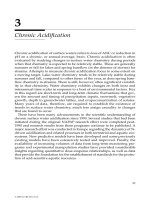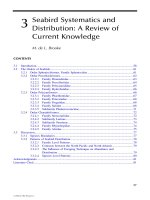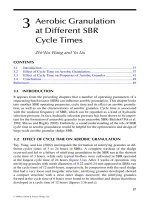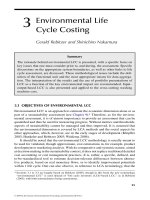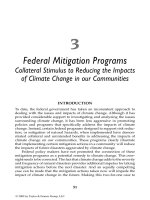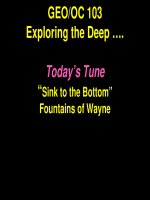Sulfate Attack on Concrete - Chapter 3 pot
Bạn đang xem bản rút gọn của tài liệu. Xem và tải ngay bản đầy đủ của tài liệu tại đây (1.18 MB, 12 trang )
3Concrete deterioration
3.1PRINCIPAL CAUSES OF CONCRETE DETERIORATION
Deterioration of concrete may be caused by chemical and physical processes,
or their combination. Chemical mechanisms include leaching of paste com-
ponents, carbonation of calcium hydroxide and C-S-H, paste deterioration
by exposure to aggressive chemicals (acids, agricultural chemicals, sulfates),
corrosion of steel reinforcement, and alkali-aggregate reactions. Physical or
mechanical causes of concrete deterioration are represented by abrasion,
erosion, cavitation and, most important, by freezing and thawing cycles. Most
chemical mechanisms of deterioration involve damage to the cement paste
matrix, but deterioration of the paste-aggregate interface, the aggregate itself,
or the pore structure often accompanies the paste deterioration. Sulfate attack,
the subject of this monograph, is a form of chemical mechanism.
A common denominator of most mechanisms of deterioration is access to
concrete of moisture. Without water, with mechanical damage such as abrasion
being an exception, no mechanism of deterioration can proceed. Examples of
such processes are of both chemical (e.g. alkali–silica reaction, corrosion of
reinforcement, sulfate attack) and physical (e.g. freezing–thawing) nature.
The general factors that accelerate or retard chemical damage of concrete
are summarized by ACI as follows (Table 3.1).
When examining concrete deterioration, one has to take into considera-
tion the local microclimate the concrete is exposed to. The concrete surface
durability may depend on the local temperature and humidity, thus an
important consideration is exposure or lack of exposure to rain, direct sun, etc.
It should be remembered that field concrete, in contrast to laboratory-made
specimens, is usually exposed to more than one mechanism of deterioration;
such situation may lead to synergistic interactions resulting in increased
rate of deterioration. If combined mechanisms are operative, it may be often
difficult to clearly identify the primary cause of the problem. Examples of
combined mechanisms of concrete deterioration are acid attack and leach-
ing, alkali–silica reaction and internal sulfate attack (e.g. delayed ettringite
formation), and carbonation and reinforcement corrosion.
© 2002 Jan Skalny, Jacques Marchand and Ivan Odler
3.1.1 Deterioration caused by dissolution of paste components
The most common phenomenon in this category is the dissolution of the
cement paste constituents, in particular portlandite, Ca(OH)
2
, present in
cement paste primarily as a consequence of hydration of clinker calcium sili-
cates. Ca(OH)
2
can be removed from the paste matrix simply due to its
inherent high solubility at a high permeability of the concrete when placed
in an environment with flowing water, or it can be the result of chemical
reactions within the paste and the subsequent removal of calcium from the
system (e.g. Marchand and Gerard 1995). The latter scenario is closely
related to issues discussed briefly in the following section and in more detail
throughout the book.
3.1.2 Deterioration caused by ingress of external chemicals
Ingress of external species into concrete and the subsequent removal of the
reaction products from the system are clearly porosity and permeability
dependent. In the absence of a permeable pore structure or, better, if the
Table 3.1 Factors influencing chemical attack on concrete.
Source: Guide to Durable Concrete (ACI 201-2R-92). Reprinted with permission by the American
Concrete Institute
Factors which accelerate or aggravate
attack
Factors which mitigate or delay attack
(1) High porosity due to
i high water absorption
ii permeability
iii voids
(1) Dense concrete achieved by
i proper mixture proportioning
ii reduced unit water content
iii increased cementitious material
content
iv air entrainment
v adequate consolidation
vi effective curing
(2) Cracks and separations due to
i stress concentrations
ii thermal shock
(2) Reduced tensile stress in concrete by
i using tensile reinforcement of
adequate size, correctly located
ii inclusion of pozzolan (to suppress
temperature rise)
iii provision of adequate construction
joints
(3) Leaching and liquid penetration
due to
(3) Structural design
i to minimize areas of contact
and turbulence
ii provision of membranes and
protective-barrier system(s)
to reduce penetration
iflowing liquid
ii ponding
iii hydraulic pressure
© 2002 Jan Skalny, Jacques Marchand and Ivan Odler
rate of penetration through the concrete matrix pore structure is low, the
probability of deterioration is dramatically decreased.
The rate of deterioration of a concrete structure by external chemicals will
depend on the following conditions:
•
concentration, chemical identity, and solubility in water of the external
reactant in the soil or water which is in contact with concrete;
•
presence of water in the soil in contact with the structure and its mobility;
•
concrete quality, including density (w/cm, porosity), degree of hydration,
and the resulting permeability; type of cement used; absence of plastic
cracks, etc.;
•
atmospheric environment of use, including temperature and temperature
variations, humidity and humidity variations, cycles of drying and wetting
(effect of wind conditions), etc.
For all types of external chemicals, whether organic or inorganic in nature,
the probability of deterioration is minimized if the concrete has low permeabil-
ity and is placed in a dry environment at constant temperature and humidity.
Understandably, such conditions are uncommon in most applications. It is
important, therefore, to recognize the above facts and consider right at the
design phase materials and processing conditions that will minimize the
potential damage. Recognition of potential problems is especially important
for construction in geographical areas known to have soils containing aggres-
sive components, and in some industrial and agricultural applications. See
for example (e.g. DePuy 1994; Reinhardt 1997; Marchand et al. 1998).
Examples of species known to damage concrete are as follows: soft waters,
acidic waters, sulfates in ground water, agricultural chemicals, etc. The condi-
tions listed above apply also to penetration of chlorides; however, chloride
penetration affects primarily the chemical stability (corrosion resistance) of
the reinforcing steel rather then the paste itself.
3.1.3Expansive reactions with aggregate
The best-known phenomena in this category are deterioration mechanisms
of concrete referred to as alkali-aggregate reactions. The most prevalent
alkali-aggregate reaction is alkali–silica reaction, ASR, characterized by the
reaction of OH
−
ions with silica contained in reactive amorphous silicates in
aggregate. The reaction leads to breaking of the -Si-O-Si- bonds in the silicate
structure and formation of calcium–alkali–silicate gel of variable composition
that may, under certain conditions, lead to cracking of the aggregate, expan-
sion of the cement paste matrix and, ultimately, to cracking and complete
destruction of the concrete structure. A typical example of ASR damage is
shown in Figure 3.1. For more information, see selected specialized liter-
ature (e.g. ASR 1974–2000; Diamond 1989; Helmuth and Stark 1992;
SHRP 1993).
© 2002 Jan Skalny, Jacques Marchand and Ivan Odler
It should be noted that field experience shows ASR to often occur in
combination with the DEF-type of internal sulfate attack. More detailed
information on this phenomenon is given in Chapters 4 and 8.
Figure 3.1(a) Alkali silica reactive flint aggregate particle in a concrete bridge
exposed to sea water. Field of view: 6.3
×
4.1 mm. Light optical microscopy:
fluorescent light (Photo courtesy of U. Hjorth Jakobsen); (b) Alkali–
silica reactive particle in concrete made with aggregate containing both
flint and silicious grains in aggregate. Field width: 5 mm, light optical
microscopy (Photo courtesy of P. Stutzman).
© 2002 Jan Skalny, Jacques Marchand and Ivan Odler
3.1.4 Frost-related deterioration
Together with damage caused by the corrosion of reinforcing steel, frost-related
decay is the most common cause of concrete deterioration. Such type of deteri-
oration is prevalent primarily in geographical areas with frequent fluctuation
of temperature around the freezing temperature of water (see Figure 3.2).
Figure 3.2 Microstructural damage to concrete aggregate and paste exposed to freez-
ing–thawing (Photos courtesy of P. Stutzman).
© 2002 Jan Skalny, Jacques Marchand and Ivan Odler
Damage caused by repeated freezing and thawing of water in concrete is
physical in nature. It is caused primarily by deterioration of the paste matrix
due to repeated mechanical stresses resulting from volume changes associated
with freezing of water into ice, but aggregate may also be affected (D-cracking).
It has to be recognized, however, that the chemical composition of the water
in concrete (pore solution) does have an effect on the freezing process. Pro-
tection against this mode of deterioration includes use of high density, good
quality concrete allowing only low water adsorption, use of air-entraining
admixtures, and limiting the access of water to the structure. Use of air-entrain-
ing admixtures is the common methodology of protection against repeated
freezing and thawing, but by itself it is not a solution unless used with good
quality concrete. For more information, see available literature (e.g. Pigeon
and Pleau 1994; Marchand et al. 1995).
3.1.5Corrosion of embedded steel
The vast majority of concrete structures, whether plain or prestressed, are
erected with imbedded reinforcing steel. The function of the steel is to give
concrete structures certain properties that cannot be achieved by concrete
itself, e.g. adequate flexural strength, modulus of elasticity, etc. Under regu-
lar field conditions, the reinforcement in good quality concrete is protected
from aggressive corroding environment by the alkaline environment of the
concrete cover and by use of otherwise protected steel surface, or both. The
steel surface itself is covered by an oxide layer that is stable in alkaline, but
not under more acidic conditions.
Under field conditions, however, the ideal conditions are often not met. In
lower quality concrete, for example concrete made with excessive water and
thus posessing high porosity and permeability, the reinforcing steel may
undergo oxidation resulting in electrochemical (cathodic plus anodic) removal
of Fe atoms from the surface.
Anodic reaction:2Fe
0
−
4 electrons
→
2Fe
2+
Dissolution ofIons in
Fe atomssolution
Cathodic reaction:O
2
−
+ 2H
2
O + 4 electrons
→
4(OH
−
)
Dissolved oxygenIons in
moleculessolution
Under such conditions the protective iron oxide layer may get damaged,
leading to excessive formation of one of several varieties of rust, followed by
expansion and delamination of concrete (see Figure 3.3).
High concrete porosity and high concentration of cracks reaching the
depth of reinforcement increase also the rate of carbon dioxide ingress, this
© 2002 Jan Skalny, Jacques Marchand and Ivan Odler
leading to carbonation of the calcium hydroxide, Ca(OH)
2
, present in the
cement paste, to form calcium carbonate, CaCO
3
.
Ca(OH)
2
+
CO
2
→ CaCO
3
+ H
2
O
This may result in a drop of pH in the cement paste that is in immediate con-
tact with the steel surface, thus allowing the corrosion of steel to take place.
Corrosion of reinforcement steel may be accelerated under conditions where
other mechanisms of damage are in action simultaneously. For example, simul-
taneous freeze–thaw conditions or exposure of concrete to aggressive sulfates may
accelerate the rate of corrosion. In a similar manner, chemical deterioration of
concrete may be aided by conditions leading to reinforcement corrosion, such as
access of chlorides and sulfates. For additional information, we recommend spe-
cialized literature (e.g Uhlig 1971; Bloomfield 1996; ACI 1992; Bentur et al. 1997).
3.1.6 Abrasion, erosion and cavitation
Forms of mechanical deterioration include abrasion, erosion, and cavitation,
all damage mechanisms caused by frictional interaction of gases, fluids or
solid particles with concrete surface.
F
igure 3.3 Concrete overpass damaged by severe corrosion of reinforcing steel
(Photo courtesy of N. Berke).
© 2002 Jan Skalny, Jacques Marchand and Ivan Odler
Abrasion is characterized by wear of concrete surface by repeated friction caused,
for example, by continuous driving on concrete pavements or industrial floors.
Erosion is a special case of abrasion, involving wear of concrete surface by
water and wind-born or water-suspended particles.
Cavitation occurs in situations where sudden change in velocity or direction
of water in contact with concrete surface causes formation of a zone of sub-
atmospheric pressure, allowing formation and subsequent collapse of pock-
ets of vapor. The collapse or implosion of these low-pressure pockets results
in localized high-pressure impact on the concrete structure, leading to mech-
anical damage. (see e.g. Mindess and Young 1981; Mehta and Monteiro
1993; Neville 1997).
As is the case with other mechanisms of deterioration, the rate of damage
due to abrasion, erosion or cavitation may accelerate if other chemical or
physical deterioration mechanisms are operative at the same time.
3.2 SELECTION OF MATERIALS
The selection of concrete mix components should be done by considering the:
•
desired properties of concrete in the environment of the expected use;
•
quality of components needed to achieve the desired concrete properties,
and;
•
availability and economic feasibility of the available sources.
Concrete components have to be selected keeping in mind the expected
service life of the structure in the environment of use. This is generally done
by compliance with the best practices of concrete making and by adhering to
national and local standards, codes and regulations. Unfortunately, for various
reasons, such compliance is not always the case, therefore use of common
sense and conservative but economically feasible approach to structural design
is recommended.
3.2.1 Importance of mix design
To produce concrete possessing the expected mechanical and chemical
properties and long-term durability, the mixture design should:
•
allow for production of fresh concrete that can be properly homogenized,
placed, and finished and
•
give the maximum possible packing density to minimize ingress of
chemical species while guaranteeing the desired structural integrity.
This is even more important when the structure is to be erected in a hostile
environment, such as cold climates or chemically aggressive soil, or when
© 2002 Jan Skalny, Jacques Marchand and Ivan Odler
availability of quality concrete raw materials is in question. It is advisable, as
the first approximation, to always use as low as possible w/cm, because pract-
ically all mechanisms of concrete deterioration are water sensitive. Decreas-
ing the access of water to a structure and minimizing transport of chemical
species through concrete are thus crucial.
3.3 CONCRETE PROCESSING
Even a properly designed concrete mixture may fail prematurely if develop-
ment of the desired chemical, microstructural, and mechanical properties is
compromised by inadequate or erratic processing. We dare to say that only a
very small volume of bad concrete produced worldwide is related to causes
other than inadequate processing. Damage to concrete is rarely caused
entirely by low-quality concrete components, as in almost all cases improper
processing is a contributing factor.
3.3.1 Mixing, curing, placing, finishing, and maintenance
Assuming proper structural and materials design, most processing damage is
introduced during mixing and curing. Placement techniques are not immune
to mistakes either and concrete maintenance is routinely ignored. Fortun-
ately, concrete is a somewhat forgiving material and, in spite of common
abuse most, but not all, concrete performs its function adequately.
Proper processing is particularly important when concrete is placed into
an aggressive environment. Inadequate mixing, for example, may lead to
inhomogeneous hardened concrete matrix, both in the solid matter itself and
in distribution of the air voids and, consequently, may result in increased
porosity and/or internal stresses. Such concrete is easier attacked by chemical
species from the environment.
Inadequate curing is a well-known reason for durability problems. In at least
one type of sulfate attack, namely so-called delayed ettringite formation
(DEF), improper curing practices are the most probable cause of damage.
Learn more about this form of internal sulfate attack in a special section of
this monograph (Section 4.3.2).
Placing and finishing of concrete, especially in “low-technology” appli-
cations like residential housing and street curbs, are most commonly abused.
Not unlike other problems in concrete processing, the reason is the inad-
equate awareness and utilization of existing knowledge. Concrete is often
considered to be an “artificial stone” that can be abused without penalty.
This is not the case. Concrete properties, including durability and service
life, are preconditioned by proper processing and timely and repeated
maintenance.
© 2002 Jan Skalny, Jacques Marchand and Ivan Odler
3.4 EFFECT OF ENVIRONMENTAL EXPOSURE
Most concrete is stable in the environment of its use. Such concrete is
designed and produced to have dense, impermeable, and mechanically
sound macro- and microstructure, the components of which are chemically
stable. If these conditions are violated, concrete, like all chemically active
materials, will react with its environment to produce chemical species that
are unstable and whose formation may result in microstructural changes that
could severely compromise the expected concrete properties.
3.4.1 Effect of chemical environment
Knowledge of the chemical nature of the soil and ground water to which a
concrete structure will be exposed during its service is crucial. The chemical
nature of the environment should be recognized before the concrete is
designed for the particular environment. As will be shown elsewhere in more
detail, such knowledge is most important in geographical areas with high
sulfate concentrations, and it is not only the concentration of sulfate anions
per se but also the type and concentration of the accompanying cations that
should be taken into consideration.
3.4.2 Effects of temperature and humidity changes
Chemical reactions of cement hydration and concrete deterioration, like
most other chemical reactions, are influenced by the reaction temperature
and, to a lesser extent, by the relative humidity. With a few exceptions, most
chemical reactions are accelerated by increased temperature, although
different chemical species are influenced to different degrees. As a result,
increased or decreased temperatures change the relative reactivities of
the species involved in hydration and deterioration processes, leading to unex-
pected modifications in solids density, microstructure, and chemical equilib-
ria when compared to the usual, expected conditions.
It is often assumed that concrete processing can be successful in a wide
temperature range without a penalty. Although this may be correct in most
cases, one should not take this for granted. Under unfavorable combination
of processing conditions (e.g. placing a concrete mixture with high content of
high-surface area cement at high ambient temperature and low relative
humidity), the resulting concrete may be susceptible to damage. Such damage
may be the result of ingress of water and of dissolved ionic species due
to high concentration in the concrete matrix of thermally-induced cracks,
inadequate degree of hydration, and resulting low early strength.
Curing of concrete is a thermo-chemical process. To properly cure con-
crete to give the best expected performance, a knowledgeable compromise
has to be used that enables all important components of the cement paste to
perform their designed function in the given time. That is the reason why not
© 2002 Jan Skalny, Jacques Marchand and Ivan Odler
only the maximum temperature and time of curing are important, but also
the time of precuring, rate of heating and cooling, and the relative humidity
of the curing environment have to be taken into consideration.
It is important to note that the individual hydration and deterioration
reactions of any concrete system are closely interrelated and influence each
other. This complexity is the reason why a particular damage mechanism
may enable another destructive mechanism to occur simultaneously; a relevant
example is the often-observed simultaneous occurrence of alkali–silica gel
(ASR) and internal sulfate damage (DEF).
3.5KNOWN PREVENTION TECHNIQUES
Prevention of concrete damage by any mechanism of deterioration will
depend on at least the following:
•
awareness of the available knowledge on the chemical and physical pro-
cesses that control the concrete quality in the given environment of use;
•
consideration of the available knowledge beginning with the design stage
(both concrete mix design and structural design), through processing, to
maintenance;
•
proper use of the existing knowledge in development of standards and
test methods; and
•
adherence to the standards, codes, and other regulations.
Literature on how to prevent sulfate attack in concrete, whether caused by
internal or external sulfate sources, is readily available. Although the recom-
mendations given in the technical literature do reflect on the complexity of the
underlying scientific phenomena and the lack of complete mechanistic under-
standing of all related issues, they are based on simple, common sense, well-
publicized ideas. It remains a fact that, although standards and testing methods
are not perfect and do not always take into consideration of all the available
knowledge (see Chapter 9 on standardization), adherence to standards and
building codes can prevent occurrence of sulfate attack in most cases.
In the Appendix part of this monograph, find recommendations for
prevention of various forms of sulfate attack. The recommendations are
based on literature references reflecting the recent best practices of
concrete making (Deutscher Ausschuss fur Stahlbeton 1989; CEN 1998;
Hobbs 1998; Skalny and Locher 1999, etc.). For detailed justification of the
proposed preventive measures see the mechanistic and practical data dis-
cussed throughout the book.
© 2002 Jan Skalny, Jacques Marchand and Ivan Odler
REFERENCES
ACI (1992) ACI Committee 201, “Corrosion of steel and other materials embedded
in concrete”, Chapter IV, In Guide to Durable Concrete, Manual of Concrete
Practice, Part 1, The American Concrete Institute, Detroit.
ASR (1974–2000) In Proceedings of the International Conferences on Alkali-Aggregate
Reaction held in Koge (1974), Cape Town (1981), Kyoto (1989), Melbourne (1996),
and Quebec (2000).
Bentur, A., Diamond, S. and Berke, N.S. (1997) Steel Corrosion in Concrete, E & FN
Spon, London.
Bloomfield, J.P. (1996) Corrosion of Steel in Concrete: Understanding, Investigation
and Repair, E & FN Spon, London.
CEN (1998) CEN/TC 104/SC 1 N 308, “Common rules for precast concrete products
(Draft 04/98)”, September.
DePuy, G.W. (1994) “Chemical resistance of concrete”, in Lamond and Klieger (eds)
Tests and Properties of Concrete, STP 169C, ASTM, Philadelphia, 263.
Deutscher Ausschuss fur Stahlbeton (1989) Recommendation on the Heat Treatment
of Concrete (in German), September.
Diamond, S. (1989) “ASR – another look at mechanisms”, in K. Okada et al. (eds)
Proceedings of the 8th International Conference on Alkali-Aggregate Reaction, The
Society of Materials Science, Tokyo.
Helmuth, R. and Stark, D. (1992) “Alkali-silica reactivity mechanisms”, in J. Skalny
(ed.) Materials Science of Concrete, Vol. III, The American Ceramic Society, Wester-
ville, OH, pp. 131–208.
Hobbs, D.W. (1998) Minimum Requirements for Durable Concrete: Carbonation- and
Chloride-induced Corrosion, Freeze–thaw Attack and Chemical Attack, British Cement
Association.
Marchand, J. and Gerard, B. (1995) “New developments in the modeling of mass
transport processes in cement-based composites”, in V.M. Malhotra (ed.) ACI
Special Publication SP-154, American Concrete Institute, Detroit, MI, pp. 169–210.
Marchand, J., Pleau, R. and Gagne, R. (1995) “Deterioration of concrete due to
freezing and thawing”, in J. Skalny and S. Mindess (eds) Materials Science of
Concrete, vol. IV, The American Ceramic Society, Westerville, OH, pp. 307–400
Marchand, J., Gerard, B. and Delagrave, A. (1998) “Ion transport mechanisms in
cement-based materials”, in J. Skalny and S. Mindess (eds) Materials Science of
Concrete, vol. V, The American Ceramic Society, Westerville, OH, pp. 283–354.
Mehta, P.K. and Monteiro, P.J.M. (1993) Concrete: Structure, Properties, and Materials,
McGraw-Hill, New York.
Mindess, S. and Young, J.F. (1981) Concrete, Prentice-Hall, Englewood Cliffs, New Jersey.
Neville, A. (1997) Properties of Concrete, 4th edn, John Wiley and Sons, New York.
Pigeon, M. and Pleau, R. (1994) Durability of Concrete in Cold Climates, Chapman &
Hall, London.
Reinhardt, H.W. (ed.) (1997) Penetration and Permeability of Concrete: Barriers to Organic
and Contaminating Liquids, RILEM Report 16, E & FN Spon, London, 332 pp.
SHRP (1993) Alkali–Silica Reactivity: An Overview of Research, SHRP-C-342,
Washington, D.C.
Skalny, J. and Locher, F. (1999) “Curing practices and delayed ettringite formation –
the European experience”, Cement, Concrete, Aggregate, ASTM, June.
Uhlig, H.H. (1971) Corrosion and Corrosion Control, John Wiley and Sons.
© 2002 Jan Skalny, Jacques Marchand and Ivan Odler
